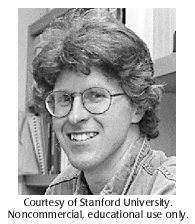பல்வேறு செல் வகைகளில் வெவ்வேறு மரபணுக்கள் செயல்பட்டிருக்கும்.



 Igor Dawid and Tom Sargent did some of the first differential gene expression studies using cDNA subtraction. Pat Brown and Steve Fodor have changed the way genomes can be screened with DNA arrays and GeneChips®
Igor Dawid and Tom Sargent did some of the first differential gene expression studies using cDNA subtraction. Pat Brown and Steve Fodor have changed the way genomes can be screened with DNA arrays and GeneChips®
Patrick Henry Brown (1954-)

Pat Brown was born in Washington, D.C. He was a good student but didn't have the all-fired certainty that he was going to be scientist. He was curious about how things worked and interested in helping people. It seemed natural for him to get both a Ph.D. in 1980 in biochemistry and an M.D. in 1982; both degrees were from the University of Chicago.
Although still undecided about a full research vs. medical career, Brown started his residency training in pediatrics at the Children's Memorial Hospital in Chicago. During his 3-year residency, while working with his patients, Brown realized that his curiosity about how things worked could help alleviate the need for understanding how genetic disorders develop. What exactly makes one person different from another and is there a practical way to distill these differences?
Brown went back to research. In 1985, he started a 3-year postdoctoral fellowship with J. Michael Bishop at the University of California, San Francisco. After his postdoc, Brown started his own lab and became a Howard Hughes Medical Institute investigator. He is Professor in the Department of Biochemistry at Stanford University School of Medicine.
Brown never forgot the idea of "genetic differences." He began thinking about the feasibility and usefulness of comparing the DNA of whole organisms ? one to another. Scientists get information about genetic similarity, evolutionary history, and conservation of function when they compare the DNA sequences of individual genes. Brown wanted to scale this up so that the entire gene complement of an organism could be compared with that of another. This would give information about variation in genetic expression and development that cannot be obtained with individual sequence comparisons. He began to think of this idea as a DNA array ? laying down DNA samples into columns and rows.
From the very beginning of this project, Brown had a very clear vision of what was needed. Sample preparation had to be cheap and easy to produce without user-unfriendly equipment. His first collaboration with an engineer failed because the mechanization of producing a DNA array became too "engineered." In the end he settled on the still-elegant fountain pen design. A solution containing DNA is sucked up into a pen and then printed onto a glass slide. With computerized automation, these DNA arrays can hold up to 80,000 samples ? more than the estimated total number of genes that make up a human being.
In 1995, Brown published the first of many papers that use DNA arrays to analyze patterns of expression. He had held workshops on how to build DNA arrays and has made the protocols available at his web site.
Brown is an advocate of freedom of information and was on the PubMed Central Advisory Committee. The Committee deals with issues of electronic exchange, storage and dissemination of scientific information by providing and promoting free electronic exchange.
When he's not working, Brown likes to spend time with his family especially his kids. He also likes to run and has participated in local marathons.


GeneChip® technology is sensitive enough to detect single base pair differences, though the hybridization conditions must be ideal.

A-T pairs have two hydrogen bonds and G-C pairs have three. How would this affect the binding of DNA onto GeneChip® especially if the single nucleotide difference is an A to a G?
 டி.என்.ஏ. குரோமோசோம்களுக்குளிருக்கும்
டி.என்.ஏ. குரோமோசோம்களுக்குளிருக்கும் உயர்ந்த செல்கள் ஒரு பண்டைய குரோமோசோம்களை ஒருங்கிணைக்கும்.
உயர்ந்த செல்கள் ஒரு பண்டைய குரோமோசோம்களை ஒருங்கிணைக்கும். சில டிஎன்ஏ'கள் புரதத்தைச் குறியிடாது.
சில டிஎன்ஏ'கள் புரதத்தைச் குறியிடாது. சில டிஎன்ஏ'கள் தாவும்.
சில டிஎன்ஏ'கள் தாவும். மரபணுக்களைச் செயல்படுத்தவும், செயலிழக்கவும் செய்ய முடியும் .
மரபணுக்களைச் செயல்படுத்தவும், செயலிழக்கவும் செய்ய முடியும் . மரபணுக்கள் இனங்களுக்கிடையே நகர்த்தமுடியும்.
மரபணுக்கள் இனங்களுக்கிடையே நகர்த்தமுடியும். டிஎன்ஏ செல்கள் வெளியிலிருந்து வரும் சிக்னல்களுக்கு செயல்படும்.
டிஎன்ஏ செல்கள் வெளியிலிருந்து வரும் சிக்னல்களுக்கு செயல்படும். பல்வேறு செல் வகைகளில் வெவ்வேறு மரபணுக்கள் செயல்பட்டிருக்கும் .
பல்வேறு செல் வகைகளில் வெவ்வேறு மரபணுக்கள் செயல்பட்டிருக்கும் . முதன்மை மரபணுக்கள் அடிப்படை உடல் திட்டங்களைக் கட்டுப்படுத்தும்.
முதன்மை மரபணுக்கள் அடிப்படை உடல் திட்டங்களைக் கட்டுப்படுத்தும். மேம்பாடு, செல்களின் வளர்ச்சி மற்றும் மரணத்தைச் சமப்படுத்தும்.
மேம்பாடு, செல்களின் வளர்ச்சி மற்றும் மரணத்தைச் சமப்படுத்தும். மரபணுக்களின் ஓர் தொகுப்பே ஒரு மரபுத்தொகுதியாகும்.
மரபணுக்களின் ஓர் தொகுப்பே ஒரு மரபுத்தொகுதியாகும். உயிரினங்கள் பொதுவான மரபணுக்களைப் பகிர்ந்து கொள்ளும்.
உயிரினங்கள் பொதுவான மரபணுக்களைப் பகிர்ந்து கொள்ளும். மனித மரபுத்தொகுதியைப் புரிந்துக்கொள்ள டிஎன்ஏ ஓர் ஆரம்பம் மட்டுமே!
மனித மரபுத்தொகுதியைப் புரிந்துக்கொள்ள டிஎன்ஏ ஓர் ஆரம்பம் மட்டுமே!